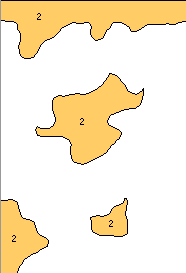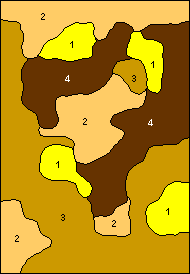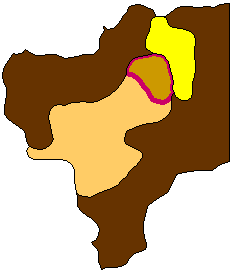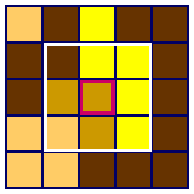Indices Of Arrangement
It would be illusory and quite tedious
to propose an exhaustive list of indices of spatial arrangement
suggested in the literature. The most productive fields of research
in this respect are certainly those of the geography, ecology,
regional sciences and the numerical image processing. From the
methodological point of view, most significant is to seize
the aspects
of the spatial arrangement which one wishes to describe through indices,
the way of interpreting them,
as well as their context of use.
The context of application of the indices of arrangement is
influenced by the following factors:
- The nature of spatial features:
- For point and
linear objects distributed in the study area,
one will describe their spatial arrangement by a measurement of
density per quadrat. We will not approach this situation within
the framework of this Unit.
- For contiguous zonal objects
proposing a spatial division of
the study area. It is on this type of context that we will pay our
attention in this Unit.
- Mode of description of the spatial distribution:
- Our major interest is certainly the description of the
arrangement of spatial objects. In object mode the units of
observation fully correspond to the spatial objects.
- In image mode, the spatial objects correspond to the
"zonal regions" produced by the aggregation of the units of
observation, the contiguous cells sharing the same property.
But it is also possible to be interested in the spatial arrangement
at the level of the neighborhood of each cell.
- The scale of description of the spatial arrangement:
- At the scale of the whole of the study area, one will account
for the "structure" of the spatial
arrangement, either globally
for all the objects, or specifically by category or class of
properties of these objects.
At the scale of the study area: “the structure”
| On the level of the spatial objects |
On the level of a group of objects with a common thematic property |
On the level of the study area |
|
|
|
|
| 12 spatial objects |
4 objects with a class of average
aptitude for agriculture
|
Distribution of the thematic
properties of the 12 objects
|
Figure 3.1 |
|
-
- At the scale of the neighborhood of
each spatial object, one will describe its
spatial context.
- At the scale of the neighborhood of the unit of
observation in image mode, one will be able to account
for the "texture"
of the spatial arrangement.
At the scale of neighborhood of the unit of observation: “the texture”
| In object mode, for each unit of observation (object) |
In image mode, for each unit of observation (cell) |
|
|
|
| Immediate neighborhood (of 1st order) of the object
with enhanced limits in red
|
Immediate neighborhood (window 3x3) and of 2nd order
(window 5x5) of the central cell
|
Figure 3.2 |
|
- Geometrical or thematic dimension of the distribution of the phenomenon:
- The geometrical indices of arrangement describe the properties of
size, of shape and the distribution in the space of a set
of objects, corresponding to all those of the study area or
to each categories or class of thematic properties present.
- The thematic indices of arrangement account for the way
in which the thematic properties are distributed on at
scale of the study area or the neighborhood of the spatial
entities. They are thus complementary to the geometrical
indices because they do not consider the shape nor the
size of spatial objects or regions. So they can apply as
well to objects or to cells.
In order to present a synthetic and structured vision these
descriptors of spatial arrangement for zonal units, we will organize
this description according to the factors of "scale of description"
and of "dimension" indices. In this Unit only major indices of spatial
arrangement will be presented, those one can find in GIS or spatial
analysis or image processing software (Idrisi, Fragstats, Envi…).





